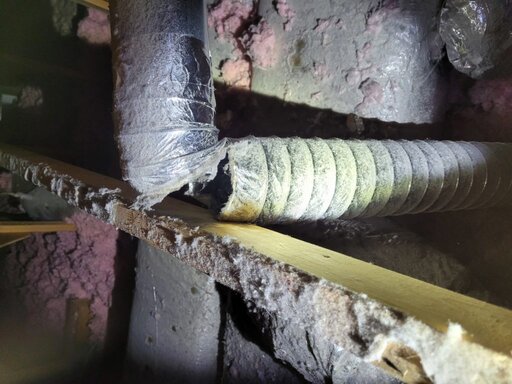
December 23, 2020
Whenever I get a call for urgent work it is usually to deal with a clogged dryer vent. Clogs are a big problem in this business, but disconnected dryer vents have become an increasing issue I wanted to post about as well. Over the past 2 weeks I have traveled to Bolton, Glastonbury, and Rocky Hill Connecticut for disconnected dryer vents. In the below post I want to relay the reasons vents become disconnected, the ways they can be repaired, and the signs to look for to determine if yours isn’t properly connected.
To reiterate from past posts, the dryer vent’s purpose is to provide a path for heat and moisture (along with fumes if the dryer is gas) to travel from your dryer to the exit of your house. Dryer vents are often comprised of multiple pipes which are taped together to create a path for the dryer’s byproducts. At each junction along the path there is a potential for the vent to disconnect. If you happen to see lint and heavy dust along areas that the dryer vent runs this can often indicate that the pipe has become disconnected and is now venting inside your house. If the vent becomes dislodged behind the machine, you’ll often notice that the laundry room becomes hot and humid while the dryer is on. If your vent runs above a ceiling and you notice water marks that do not correlate with your house’s plumbing, this could indicate that moisture from the dryer has escaped the vent and is hitting the sheetrock. These are indicators that the vent is no longer functional and needs repair.
When a vent becomes disconnected there is usually a reason for it. If the vent is heavily clogged with lint the airflow from the dryer may “pop” a seam. Duct tape (rather than foil tape) is often used in many older vents to stabilize the connections between pipes. Over time duct tape dries out and loses its ability to maintain the connection. Other reasons a pipe may become disconnected include people accidentally knocking it lose, poor vent design, lack of stabilizing measures, and repeated vibration caused through use.
The sure-fire way to determine if your vent has become disconnected is to turn on the dryer and check the exhaust (where the dryer vent exits your home) for airflow. If the dryer is on and no air is coming out (or it is coming out weak) you likely have a clogged vent or disconnected one.
As always, we encourage you to call us at (860)414-4206 if you are in Connecticut and experiencing any dryer venting issues. For disconnected vents we will locate the problem and repair it. If repairing it is not possible we will work with you to formulate a plan.